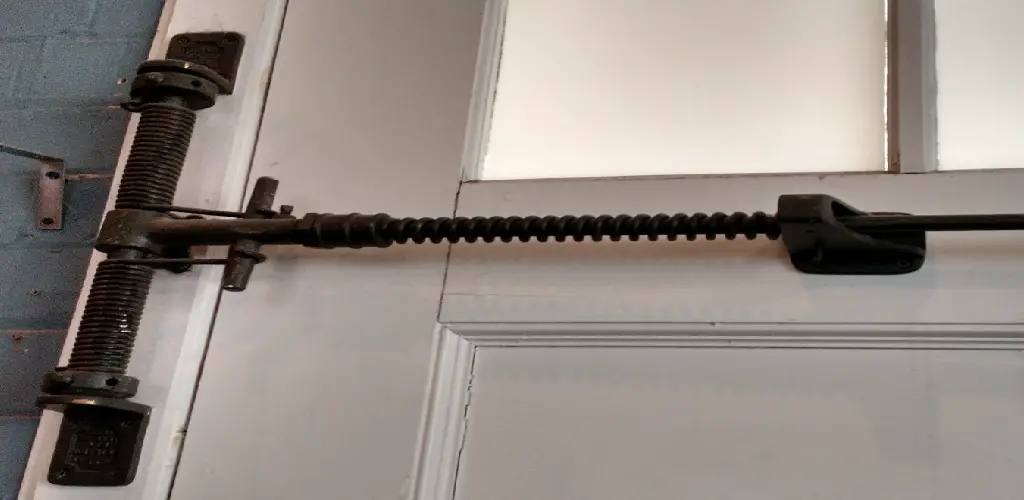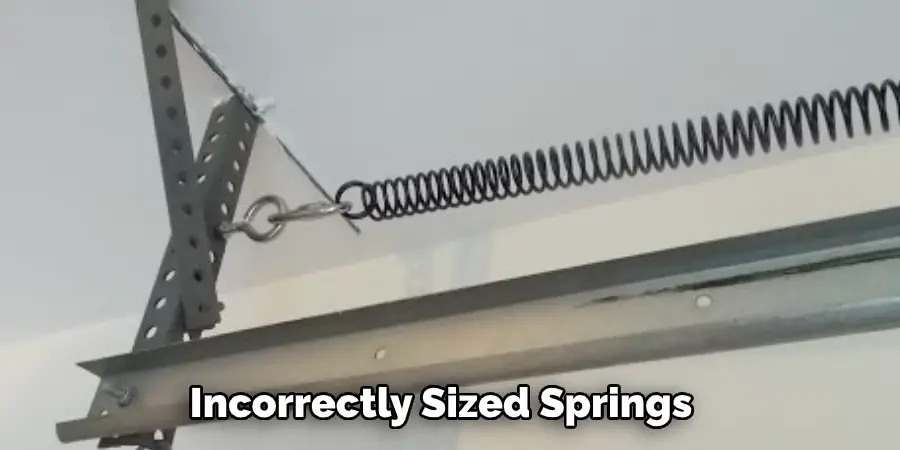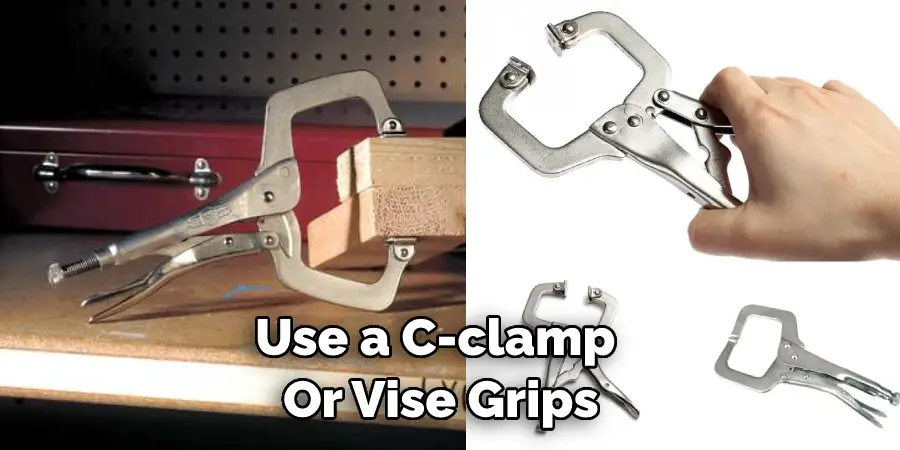If you are like most people, your garage door is one of the largest and most important pieces of equipment in your home. But, if your garage door spring breaks, it can be difficult to know what to do. Luckily, there are some things you can do to open your garage door until you can get it fixed.

In this blog post, we’ll teach you how to open a garage door with a broken spring. We’ll also discuss some of the potential causes of a broken garage door spring and provide tips for preventing future breakages. Read on for more information!
Summary: Opening a garage door with a broken spring can be a challenging task, but it can be done with some careful planning and execution. To start, disconnect the opener and manually lift the door from the bottom while being cautious and aware of the extra weight. Use a sturdy object like a step ladder to prop the door open and maintain its position. Repairing the spring immediately is crucial, as operating the door in this manner can cause further damage and pose a safety risk.
Seven Reasons That Causes a Faulty Spring in Garage Door:
1. Lack of Proper Maintenance:
Not cleaning and maintaining the garage door regularly can lead to the development of rust on its parts, which in turn will put extra strain on the springs and cause them to break. If you think your springs need replacing, have a professional look at them to ensure they’re in good shape before proceeding.
2. Worn-Out Parts:
The springs in your garage door are under much tension, so it’s not surprising that they eventually wear out. If you notice your door isn’t opening and closing as smoothly as it used to, the springs likely need to be replaced.
3. Extreme Weather Conditions:
If you live in an area that experiences extreme weather conditions, this can also cause your garage door springs to break. Hot weather can cause the springs to expand, while cold weather can make them contract, which can lead to breakage.
4. Poor Installation:
If the springs in your garage door were not installed properly, this could also cause them to break. Make sure to have a professional handle the installation of your garage door springs to avoid this issue.
5. Too Much Weight:
If you try to open or close your garage door when it’s too heavy, this can also cause the springs to break. If you notice your door is starting to sag, it’s likely because the springs cannot support the weight anymore and need to be replaced.
6. Incorrectly Sized Springs:
If the springs in your garage door are not the same size, the door will be unbalanced. This can cause the door to open or close unevenly and put unnecessary strain on the opener motor. To fix this problem, replace the springs with ones of equal size.

7. Worn-Out Rollers:
If your garage door rollers are worn out, this can cause the door to be unbalanced and put extra strain on the springs. Replacing the rollers is a simple fix that can help extend the life of your springs.
14 Effective Steps on How to Open a Garage Door With a Broken Spring:
Step 1: Assess the Situation
Before attempting to open a garage door with a broken spring, evaluate the situation and determine the extent of the damage. Garage door springs are crucial components for counterbalancing the weight of the door, allowing it to open and close smoothly. Operating a garage door with a broken spring can be dangerous and lead to further damage. Proceed with caution and prioritize safety at all times.
Step 2: Identify the Type of Spring System
Garage door spring systems typically fall into two categories: extension springs and torsion springs. Extension springs are mounted on either side of the door and stretch when the door is closed, while torsion springs are located above the door and wind up when the door is closed. Knowing the type of spring system will help you understand the appropriate steps for opening the door safely.
Step 3: Gather Necessary Tools and Equipment
To safely open a garage door with a broken spring, you’ll need the following tools and equipment:
- Two or more sturdy C-clamps or locking pliers
- A pry bar or a piece of sturdy wood
- Work gloves
- Safety goggles
- An assistant, if available
Step 4: Secure the Garage Door
Before attempting to open the door, it’s essential to secure it in place to prevent it from crashing down suddenly. If your garage door has extension springs, use C-clamps or locking pliers to secure the door tracks just above the bottom rollers. If your garage door has torsion springs, secure the door by clamping the track above the middle rollers.
Step 5: Disconnect the Garage Door Opener
To prevent the garage door opener from engaging while you’re opening the door manually, disconnect the opener by pulling the emergency release cord. The cord is typically red and hangs from the garage door opener.
Step 6: Open the Door with Assistance
Enlist the help of a friend or family member for this step, as the garage door will be significantly heavier without the support of the springs. With one person on each side of the door, use the pry bar or a piece of sturdy wood to lift the door from the bottom. Lift the door evenly and slowly, ensuring it remains level as you raise it. Be prepared for the door to feel much heavier than usual, as the broken spring will no longer assist in lifting it.
Step 7: Secure the Door in the Open Position
Once the garage door is fully open, use C-clamps or locking pliers to secure the tracks just below the top rollers, preventing the door from sliding down unexpectedly. Make sure the door is securely in place before proceeding.
Step 8: Address the Broken Spring
With the door safely open and secured, it’s time to address the broken spring. Garage door spring replacement can be dangerous due to the high tension stored in the springs, and it’s generally recommended to hire a professional to perform the repair. If you’re confident in your abilities and have experience with garage door repairs, you can attempt to replace the spring yourself, but exercise extreme caution and follow all safety guidelines.
Step 9: Reconnect the Garage Door Opener
After the broken spring has been replaced, reconnect the garage door opener by re-engaging the emergency release cord. Test the door’s operation using the opener to ensure everything is functioning correctly.
Step 10: Test the Garage Door
With the broken spring replaced and the opener reconnected, test the garage door by opening and closing it several times, both manually and with the opener. Check for smooth operation, proper alignment, and any unusual sounds or movements. Address any issues as needed.
Step 11: Maintain Regular Inspections and Maintenance
To prevent future issues and prolong the life of your garage door system, perform regular inspections and maintenance. Check for signs of wear or damage to the door, tracks, rollers, and springs, and address any issues as needed. Lubricate moving parts regularly and keep the tracks clean and free of debris. Proper maintenance can help reduce the risk of broken springs and other garage door problems.
Step 12: Consider Replacing Both Springs
If one spring has broken, the other spring is likely to fail soon as well, as both springs have likely experienced a similar amount of wear and tear. To prevent having to open the garage door manually with a broken spring again in the near future, consider replacing both springs at the same time. This will ensure that both springs have the same amount of tension and provide balanced support for the garage door.
Step 13: Be Aware of the Lifespan of Garage Door Springs
Garage door springs have a limited lifespan, typically between 10,000 and 20,000 cycles (one cycle is equivalent to the door opening and closing once). Be aware of the age of your garage door springs and consider replacing them preemptively when they approach the end of their lifespan. This can help prevent unexpected spring failures and the need to open the door manually with a broken spring.
Step 14: Consider Upgrading to a High-Cycle Spring
If you use your garage door frequently, you may want to consider upgrading to a high-cycle spring, which can have a lifespan of up to 100,000 cycles. While high-cycle springs may be more expensive upfront, they can provide greater longevity and reduce the need for frequent spring replacements.
By following these steps, you can safely and effectively open a garage door with a broken spring. Remember to prioritize safety, enlist assistance, and secure the door throughout the process. Regular maintenance, inspections, and addressing issues as they arise can help prevent future spring failures and ensure the smooth operation of your garage door system.
Some Helpful Tips and Suggestions:
Here we have given some tips on how to open a garage door with a broken spring.

- If your garage door has a broken spring, it is important to open it carefully to avoid injuring yourself.
- Use a rope or bungee cord to secure the door in the open position.
- If possible, remove the broken spring from the garage door before opening it.
- Make sure you have enough clearance to open the door fully before proceeding.
- Be careful not to damage the garage door or tracks when opening it.
- If you see any damage to the door, tracks, or spring, do not attempt to open it and call a professional for assistance.
Few Things to Consider Before Opening a Garage Door With a Broken Spring
1. Make Sure You Have Plenty of Clearance:
You will want to ensure that you have plenty of clearance to open and close the door. If you do not have enough clearance, you may not be able to open the door all the way. When measuring, make sure to take into account the height of your car.
2. Make Sure the Power is Off:
Be sure to turn off the power to the garage door opener before attempting to open the door manually. Also, always check to see if the red light on the garage door opener is off. If it is not, the power is still on, and you could be electrocuted. So be sure to take all necessary safety precautions.
3. Know How Much Weight the Door Can Hold:
The garage door springs are designed to hold a certain amount of weight. If you try to open the door and it is too heavy, the springs could break and cause serious injury. So be sure to check how much weight the door can hold before opening it.
4. Be Careful of the Door:
The garage door is a very heavy object and can cause serious injury if it falls on you. So be sure to be careful when opening the door manually. Make sure to hold on to the door firmly and brace yourself if it falls.
5. Check the Springs:
The springs on a garage door can be very dangerous. If they break, they can cause the door to fall on you. So be sure to check them regularly for wear and tear. If you see any damage, replace them immediately.

6. Be Careful of the Cables:
The cables on a garage door are under a lot of tension. If you are not careful, they can snap and cause the door to come crashing down. Always disconnect the power to the door before attempting any repairs to be safe.
You Can Check It Out to Hang Drywall in Garage
Conclusion:
Garage door repair is a common household project that many people are capable of completing. Unfortunately, it may be necessary to replace the entire garage door opener system in some cases. However, the broken spring can be replaced without too much trouble in most cases. Garage door springs can break for several reasons, including age, wear and tear, or improper installation.
If your garage door spring breaks, it can be difficult to open the door. In this blog post, we have already covered how to open a garage door with a broken spring. We have also covered a few tips and suggestions to make sure you can complete the task safely. If you have any further questions, feel free to leave a comment below, and we will be happy to help.
I am Rick. I grew up helping my dad with his handyman service. I learned a lot from him about how to fix things, and also about how to work hard and take care of business. These days, I’m still into fixing things- only now, I’m doing it for a living.
I’m always looking for new ways to help people grow and develop. That’s why I have created this blog to share all my experience and knowledge so
that I can help people who are interested in DIY repair.
